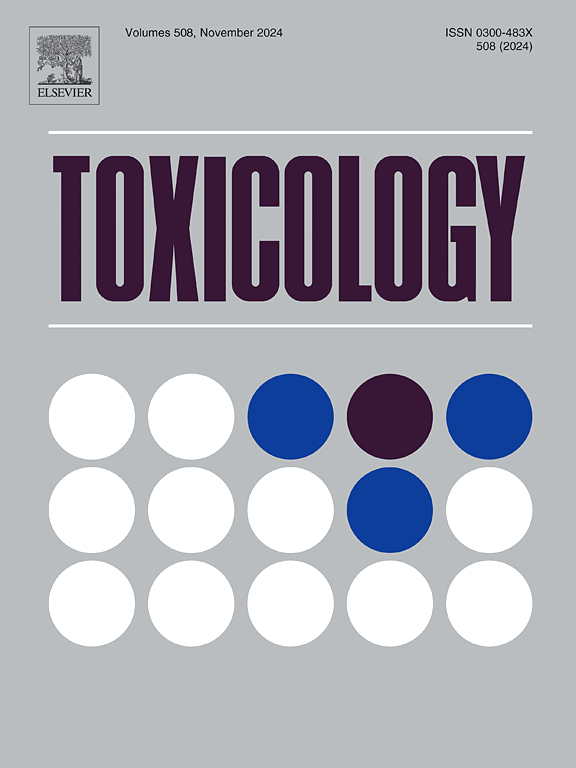枸杞酸的体外对映体特异性肝毒性,并试图修改其毒性作用
IF 4.6
3区 医学
Q1 PHARMACOLOGY & PHARMACY
引用次数: 0
摘要
Usnic酸是一种手性次生地衣代谢物,具有多种生物活性,但对其肝毒性的担忧限制了其治疗潜力。值得注意的是,其两种形式(+)-和(−)-usnic酸的对映体特异性作用仍未得到充分研究。本研究旨在通过评估其对细胞活力、膜完整性和线粒体功能的影响,比较不同浓度的枸杞酸对HepG2细胞的肝毒性潜能。此外,我们研究了是否可以通过与已知的肝保护剂(水飞蓟宾、角鲨烯和n -乙酰半胱氨酸)共同治疗来减轻肝毒性。我们的研究结果首次证明,(−)-usnic酸表现出比(+)-对映体更大的肝毒性,特别是在暴露24-48 h后(IC₅₀:16.0 vs. 28.2 µg/mL, 48 h)。LDH渗漏和线粒体膜去极化证实了这种对映体特异性毒性,(−)-usnic酸诱导的作用更为明显。在48 h时,与肝保护剂联合治疗可部分减轻毒性,其中角鲨烯和n -乙酰半胱氨酸的保护作用优于水飞蓟宾。然而,72 h后,保护作用减弱。这些发现强调了对映体特异性分析在天然化合物安全性评估中的重要性,并表明乌耳酸的肝毒性不仅仅受到线粒体解偶联的影响。进一步的体内研究和机制分析是评估枸杞酸的临床潜力和确定安全治疗使用策略的必要条件。本文章由计算机程序翻译,如有差异,请以英文原文为准。
Enantiospecific hepatotoxicity of usnic acid in vitro, and the attempt to modify the toxic effect
Usnic acid, a chiral secondary lichen metabolite, is known for its diverse biological activities, yet concerns about its hepatotoxicity limit its therapeutic potential. Notably, the enantiospecific effects of its two forms, (+)- and (−)-usnic acid, remain underexplored. This study aimed to compare the hepatotoxic potential of the enantiomers of usnic acid in wide range of concentration to HepG2 cells, by evaluating their impact on cell viability, membrane integrity, and mitochondrial function. Additionally, we investigated whether hepatotoxicity could be mitigated by co-treatment with known hepatoprotectants: silybin, squalene, and N-acetylcysteine. Our results demonstrated for the first time that (−)-usnic acid exhibited significantly greater hepatotoxicity than its (+)-enantiomer, particularly after 24–48 h of exposure (IC₅₀: 16.0 vs. 28.2 µg/mL at 48 h). This enantiospecific toxicity was confirmed by LDH leakage and mitochondrial membrane depolarization, with more pronounced effect induced by (−)-usnic acid. Co-treatment with hepatoprotectants partially alleviated toxicity at 48 h, with squalene and N-acetylcysteine showing better protective effects than silybin. However, the protective effects diminished after 72 h. These findings underscore the importance of enantiospecific analysis in natural compound safety assessments and suggest that the hepatotoxicity of usnic acid is influenced by more than just mitochondrial uncoupling. Further in vivo studies and mechanistic analyses are necessary to evaluate the clinical potential of usnic acid and to identify strategies for safe therapeutic use.
求助全文
通过发布文献求助,成功后即可免费获取论文全文。
去求助
来源期刊

Toxicology
医学-毒理学
CiteScore
7.80
自引率
4.40%
发文量
222
审稿时长
23 days
期刊介绍:
Toxicology is an international, peer-reviewed journal that publishes only the highest quality original scientific research and critical reviews describing hypothesis-based investigations into mechanisms of toxicity associated with exposures to xenobiotic chemicals, particularly as it relates to human health. In this respect "mechanisms" is defined on both the macro (e.g. physiological, biological, kinetic, species, sex, etc.) and molecular (genomic, transcriptomic, metabolic, etc.) scale. Emphasis is placed on findings that identify novel hazards and that can be extrapolated to exposures and mechanisms that are relevant to estimating human risk. Toxicology also publishes brief communications, personal commentaries and opinion articles, as well as concise expert reviews on contemporary topics. All research and review articles published in Toxicology are subject to rigorous peer review. Authors are asked to contact the Editor-in-Chief prior to submitting review articles or commentaries for consideration for publication in Toxicology.
 求助内容:
求助内容: 应助结果提醒方式:
应助结果提醒方式:


